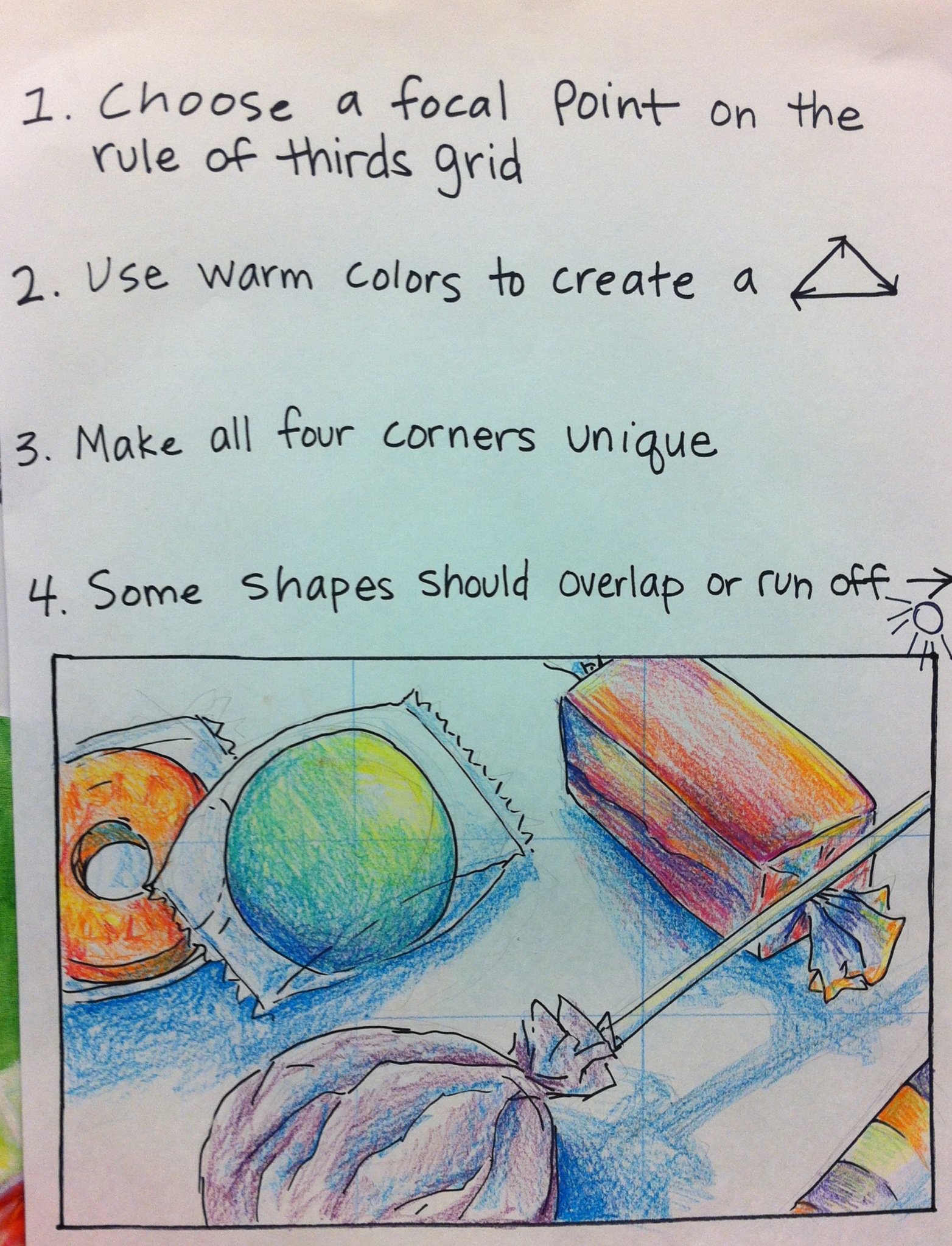Wayne Thiebaud Candy Compositions
thumbnail sketching stage with candy on card stock grid
Lesson Title: Wayne Thiebaud Candy Compositions
Concepts: Composition, Acrylic Painting, Color Theory
Appropriate Grade Levels: 5th - High School
Lesson Rationale/Overview: After a unit using shape and color to create successful compositions, students will create a small candy still-life on a rule of thirds grid to use as the subject for a large scale acrylic painting. This painting is created in five stages:
- colored pencil outline sketch on canvas (including a rule of thirds grid)
- gradient background in acrylic paint glaze
- warm and cool isolations for highlight and shadow
- local color in acrylic paint glaze
- overpainting
Goals and Standards:
Grade 5-8 Visual Arts Standard 1: Understanding and applying media, techniques, and processes
Grade 5-8 Visual Arts Standard 5: Reflecting upon and assessing the characteristics and merits of their work and the work of others
Learner Outcomes: Students will be familiarized with one method of creating an acrylic painting from start to finish. They will experiment with the acrylic paint as a medium, especially the technique of layering in glazes.
Materials Needed for Lesson:
painting gradient backgrounds with acrylic glazes
- assorted candies (check your classroom allergy list for possible issues)
- card stock cut into small rectangles, printed with a rule of thirds grid
- glue gun
- canvases
- water bins or cups
- mixing palettes
- acrylic paint palettes
- paintbrushes in assorted shapes and sizes
Materials for Students with Special Needs:
- labeled paint palette for students with anomalies in color vision
- personal visual organizer of steps
- paintbrushes with rubberized grip
Lesson Procedures:
1. Starting the Lesson: Introduce Wayne Thiebaud and discuss his use of color in composition. Review basic composition rules (as shown in the first photo below) before students experiment with arranging five candies. They will create 4 possible arrangements with these candies and then choose the most successful composition. Once chosen, the candies can be hot-glued to the card stock grid (as shown in the second photo below). If students complete this stage before their peers, they can move ahead to prepare their canvas with a rule of thirds grid sketched in colored pencil.
2. Behavioral Expectations: Students will be responsible for keeping their workspace neat and treating the materials with respect (especially washing their brushes in between colors). Students are expected to give informal constructive peer critique through the studio process to guide each other.
3. Organizer: Break each studio session down into three or four steps and write it on the board, or project it on a screen, so students know the next layer they can proceed to if they complete their current step.
4. Lesson Sequence:
- Experiment with multiple composition sketches, pick the most successful sketch
- Glue candies to card stock grid in the chosen arrangement
- Sketch contours (outlines) of the shapes on canvas using a light colored pencil
- Paint a gradient background using two or three analogous colors in a transparent acrylic glaze
- Paint areas of highlights using a transparent glaze of yellow paint
- Paint areas of shadows using a transparent glaze of blue paint (don't forget cast shadows on the background)
- Allow this layer to dry (preferably overnight or between classes)
- Paint candies with a transparent glaze of "local color," or the actual colors of the candies (The previous layer of highlight and shadow should show through)
- Allow this layer to dry (preferably overnight or between classes)
- Demonstrate multiple methods of shading in thicker acrylic paint for the overpainting, use Thiebaud examples as a reference. NOTE: White paint is given only at this stage in the project. Black paint is never distributed, rather students are encouraged to mix their own unique dark tones using a combination of deep blue, purple, red and green.
- Students will peer critique and take notes to guide their finishing touches.
- Group critique using this method






